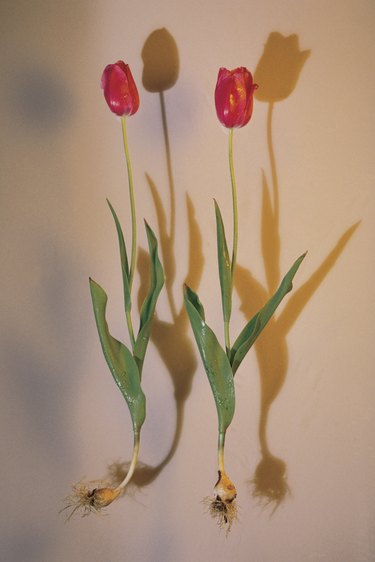
It wouldn't occur to most people who look at a beautiful bed of flowering tulips that the plants would be edible. At times, though, tulips were eaten. In Holland in World War II, people were starving, so they tried eating some of the tulip bulbs they raised for commerce. Sometimes curious people noted the bulb's resemblance to an onion and used them as onion substitutes. All parts of the plant except the petals, however, contain toxic compounds that can cause illness.
Symptoms of Tulip Poisoning
Video of the Day
Tulips contain alkaloid and glycoside compounds that are toxic and are concentrated in the bulb. Eating tulip bulbs can cause dizziness, nausea, abdominal pain and, rarely, convulsions and death. In a case reported by David Spoerke and Susan Smolinske in "Toxicity of Houseplants," people who ate a cooked dish containing tulip bulbs developed difficulty in breathing, sweating, vomiting and intense salivation within 10 minutes of eating the dish but all recovered.
Video of the Day
Toxic Compounds
Alkaloid glycosides consist of a molecule where a sugar is linked with oxygen to another compound that usually contains nitrogen. Digestive juices strip the sugar molecule from the second compound by breaking the oxygen bond, turning them into toxic compounds. Rarely, tulip glycoproteins can cause human red blood cells to clump together. Tulips manufacture the glycosides tulipalin A and B and tuliposide A and B as part of normal plant development rather than producing them in response to pathogen attacks.
Skin Problems
Two allergens present in tulip bulbs are tulipin A and tulipin B, which can cause skin rashes and nail brittleness. People who handle tulip bulbs in horticultural operations or tulip-packing sheds and have a high exposure to tulip bulb dust can develop symptoms not only in their hands but in parts of the body that haven't touched the bulb dust. An early symptom of tulip dermatitis is tingling in the fingers. Symptoms may not appear until 12 hours after exposure to tulip allergens, and not all people are sensitive to the allergens. Call a poison control center or a doctor if symptoms of tulip poisoning appear.
Other Reactions and Uses
Sensitive people may also develop allergic symptoms in nasal passages and eye irritation, conjunctivitis and swollen eyelids. Sometimes tulip petals, which are not toxic, serve as garnishes or ingredients in desserts and salads. The taste varies according to the cultivar used, with flavors ranging from that of sweet lettuce to baby peas or cucumbers. The flowers, however, may contain allergic substances that some people are sensitive to. If you experience tingling or numbness by touching the flowers or have any doubts about eating them or serving them, don't use the petals.
- Nova Scotia Museum: Poison Centre Information: The Poison Plant Patch: Tulip (Tulipa)
- CookAdvice.com: Tulip, Crab and Asparagus Appetizers
- Government of Canada: Canadian Biodiversity Information Facility: Notes on Poisoning: Tulipa Gesneriana
- What's Cooking America: Edible Flowers: Edible Flowers Are the New Rage in Haute Cuisine
- American Society of Plant Biologists: Antimicrobial Activities of Anthers in Tulips